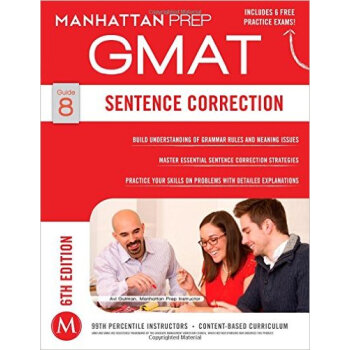

具体描述
内容简介
Adapting to the ever-changing GMAT exam, Manhattan Prep’s 6th Edition GMAT Strategy Guides offer the latest approaches for students looking to score in the top percentiles. Written by active instructors with 99th-percentile scores, these books are designed with the student in mind.The industry-leading GMAT Sentence Correction Strategy Guide delves into every major principle and minor subtlety of grammar tested on the GMAT. From its comprehensive list of GMAT-specific idioms to its tailored coverage of topics such as pronouns and parallelism, this guide teaches exactly what students need for GMAT Sentence Correction—and nothing that they don’t. Unlike other guides that attempt to convey everything in a single tome, the GMAT Sentence Correction?Strategy Guide is designed to provide deep, focused coverage of one specialized area tested on the GMAT. As a result, students benefit from thorough and comprehensive subject material, clear explanations of fundamental principles, and step-by-step instructions of important techniques. In-action practice problems and detailed answer explanations challenge the student, while topical sets of Official Guide problems provide the opportunity for further growth. Used by itself or with other Manhattan Prep Strategy Guides, the GMAT Sentence Correction?Strategy Guide will help students develop all the knowledge, skills, and strategic thinking necessary for success on the GMAT. Purchase of this book includes one year of access to Manhattan Prep’s online computer-adaptive GMAT practice exams and Sentence Correction Question Bank.?All of Manhattan Prep's GMAT Strategy Guides are aligned with the 2016 Edition GMAC Official Guide.
作者简介
In 2000, Teach for America alumnus and Yale graduate Zeke Vanderhoek had a radical idea: students learn better from better teachers. His vision of what test prep could be if written and taught by great educators led him to start Manhattan Prep. Since we began, Manhattan Prep has grown from a boutique tutoring company to one of the world’s leading test prep providers, offering GMAT, GRE, LSAT, ACT, and SAT courses and tutoring worldwide.We believe test prep should be real education. From our instructors to our materials, we work to teach you the skills you’ll need to succeed on the test, in school, and beyond.,Founded in 2000 by a Teach for America alumnus, Manhattan Prep is a leading test prep provider with locations across the US and the world. Known for its unparalleled teaching and curricular materials, the company’s philosophy is simple: help students achieve their goals by providing the best curriculum and highest-quality instructors in the industry. Manhattan Prep’s rigorous, content-based curriculum eschews the “tricks and gimmicks” approach common in the world of test prep and is developed by actual instructors with 99th percentile scores. Offering courses and materials for the GMAT, GRE, LSAT, and SAT, Manhattan Prep is the very best.,
用户评价
这本书的内容就像是一本老旧的百科全书,知识点很多,但更新的速度好像跟不上考试的变化。我感觉它提供的很多语法规则和例句,都像是陈年旧事,虽然经典,但未必完全符合当下 GMAT 考试的最新趋势。我试着去理解书中关于“动词时态”的讲解,但里面的很多例子,放在现代英语语境下,似乎有些牵强,或者说,不那么常用。我总觉得,这本书更像是为了教授纯粹的英语语法知识而存在,而不是为了帮助我考出一个好成绩。我更需要的是一本能够紧密结合 GMAT 考试风格,提供最新、最实用的解题技巧的书。这本书的语言风格也比较严肃,缺乏一些鼓励和指导性,读起来总感觉有点枯燥乏味。我希望能找到一本能够让我感觉“学有所用”,并且能显著提升我应试能力的书。
评分这本书的内容实在太庞杂了,我感觉自己像是在迷宫里打转。初翻开时,就被密密麻麻的语法规则和例句吓住了,很多概念都非常抽象,像是隔着一层纱在看东西,总抓不住核心。我试图去理解那些长难句的分析,但很多时候,即使看了讲解,自己尝试的时候还是会出错。比如,对于平行结构的处理,书中给出了不少例子,但有些例子之间的细微差别我真的很难分辨,也不知道什么时候可以用,什么时候不行。而且,它的逻辑跳跃性有点强,上一页还在讲主谓一致,下一页就跳到了代词指代,中间缺乏一个清晰的过渡,让我很难把知识点串联起来。我发现自己花了大量时间在背诵和理解那些规则,但实际做题的时候,却常常因为不确定而犹豫不决,感觉学习效率不高。我希望这本书能在概念的引入上更循序渐进一些,或者提供更多由浅入深的练习,这样我才能一点点建立起信心,而不是被海量的信息淹没。
评分我必须说,这本书的题目数量和难度都让我感到有些吃力。它似乎总是把我放在一个“我已经完全掌握了所有语法知识”的起点上,然后开始抛出各种各样刁钻的题目。对于初学者来说,我感觉这本书的门槛实在是太高了。很多题目我甚至连句子的意思都还没完全理解,就已经被各种语法错误选项搞得眼花缭乱了。更令人沮丧的是,书中的解析部分,有时候只是简单地指出哪个选项是正确的,但对于为什么其他选项是错误的,解释得不够充分,或者解释得过于专业,我依然无法完全理解。我希望这本书能提供一些更系统性的解题方法,比如如何进行错误排除,或者如何根据题干的线索来快速定位考点。现在这样,我感觉我是在跟题目硬碰硬,而不是在学习一种方法。
评分这本书的排版和设计给我留下了一种…嗯,怎么说呢,就是那种非常朴实的风格,甚至可以说有点简陋。满满的文字,字号也不大,一开始看的时候就觉得有点吃力。我特别不喜欢的是,很多例句都非常长,而且句子结构本身就比较复杂,再加上大量的语法分析,读起来简直像在啃一本厚厚的法律条文。我反复看了几遍关于“限定性定语从句”和“非限定性定语从句”的区别,但例句里的变化总是让我感到困惑。有时候,我认为是限定性的,但答案却是非限定性的,反之亦然。我感觉这本书在句子选择上,可能过于追求展示各种语法点,而忽略了句子的可读性和学习者的接受程度。我期待的可能是一本能用更生动、更具象化的方式来解释语法概念的书,而不是这样堆砌各种复杂的例句。
评分老实说,这本书给我的感觉非常“学院派”。它更像是语法教科书的浓缩版,充满了各种专业的术语和精细的划分。虽然理论上讲得很透彻,但对于我这种需要快速掌握考试技巧的学生来说,显得有些过于理论化了。我尝试着去钻研里面的每一条规则,但很多时候,我发现自己只是在机械地记忆,而无法真正理解其背后的逻辑和应用场景。比如,关于修饰语的位置问题,书中列举了各种可能的情况,但我每次做题都得回过头来对照规则,而不是凭感觉就能判断。我感觉这本书更适合那些有扎实语言基础,想要进行深度语法梳理的学习者。对我而言,我更希望这本书能提供一些更直接、更实用的解题策略,比如如何快速识别句子中的错误类型,或者在有限的时间内做出最有效的判断。现在这样,感觉我花了很多时间在“知道”语法,但却没有真正学会“运用”语法去解决问题。
评分正版书就是放心
评分不错,就是略贵
评分正版书就是放心
评分正版书就是放心
评分不错,就是略贵
评分不错,就是略贵
评分经典书,gmat必备
评分正版书就是放心
评分经典书,gmat必备
相关图书
本站所有内容均为互联网搜索引擎提供的公开搜索信息,本站不存储任何数据与内容,任何内容与数据均与本站无关,如有需要请联系相关搜索引擎包括但不限于百度,google,bing,sogou 等
© 2025 book.idnshop.cc All Rights Reserved. 静思书屋 版权所有

![Explore My World Planets 英文原版 [平装] [03--07] pdf epub mobi 电子书 下载](https://pic.tinynews.org/19686639/57844cfaN1248d677.jpg)













![Charlotte's Web 夏洛特的网 英文原版 [精装] [8岁及以上] pdf epub mobi 电子书 下载](https://pic.tinynews.org/19004137/550bf364Na9c74668.jpg)
![Splish, Splash! (My First I Can Read)[大家一起来洗澡!] [平装] [3-5岁] pdf epub mobi 电子书 下载](https://pic.tinynews.org/19005024/550bf277Nb0de016b.jpg)
![The Mysterious Benedict Society and the Perilous Journey [平装] [8-12岁] pdf epub mobi 电子书 下载](https://pic.tinynews.org/19008763/7c00e572-1385-43af-9a3a-89825c2e0c1d.jpg)
![The Twilight Saga: New Moon (Movie Tie-in)[暮光之城:新月] 英文原版 [平装] pdf epub mobi 电子书 下载](https://pic.tinynews.org/19008809/rBEhVVLk0CIIAAAAAACJltCQ14IAAIVnwKYJysAAImu850.jpg)
![Beezus and Ramona雷蒙娜和姐姐 英文原版 [平装] [8-12岁] pdf epub mobi 电子书 下载](https://pic.tinynews.org/19009152/550be69cN07bfd6c1.jpg)
![All Aboard the Circus McGurkus[Board Book][苏斯博士:马戏团成员请上船(卡板翻翻书)] [平装] [2岁及以上] pdf epub mobi 电子书 下载](https://pic.tinynews.org/19016324/405553a7-4798-43f3-bcaa-0f0f29365c20.jpg)